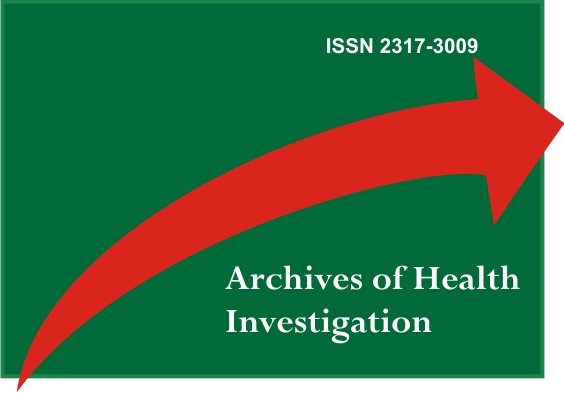Tumefacción Submandibular con Diagnóstico Inesperado
DOI:
https://doi.org/10.21270/archi.v11i4.5403Palabras clave:
Anamnesis, Cálculos de las Glándulas Salivales, Diagnóstico BucalResumen
Objetivo: Informar el caso de un paciente de 68 años remitido para evaluación de posible tumor odontogénico. El paciente presentaba un nódulo submandibular de 2 años de evolución, de unos 2 cm, endurecido, móvil y asintomático en región submandibular derecha. Después de un cuidadoso examen clínico y análisis de radiografía panorámica, el diagnóstico presuntivo fue sialolito. A continuación, se realizó la extirpación quirúrgica sin complicaciones y, tras el análisis histopatológico, se confirmó el diagnóstico clínico. Conclusión: Las evaluaciones clínicas, radiográficas e histológicas son siempre un desafío para el correcto diagnóstico de lesiones duras en la cavidad bucal.
Descargas
Citas
Ledesma-Montes C, Garcés-Ortìz M, Salcido- Garcìa JF, et al. Giant sialoloth : case report and review of the literature. J Oral Maxillofac Surg 2007;65:128-30.
Gupta A., Rattan D., Gupta R. Giant sialoliths of submandibular gland duct: report of two cases with unusual shape. Contemp Clin Dent. 2013;4(1):78-80.
Alves NS, Soares GG, Azevedo RS, Camisasca DR. Sialólito de grandes dimensões no ducto da glândula submandibular. Rev Assoc Paul Cir Dent. 2014;68(1):49-53.
Berlucchi M. Oral Granular Cell Tumor Mimicking a Giant Sialolith in a Child. J Pediatr. 2018;196:322
Andretta M, Tregnaghi A, Prosenikliev V, Staffieri A. Current opinions in sialolithiasis diagnosis and treatment. Acta Otorhinolaryngol Ital 2005;25:145-49.
Merino GA. Sialoendoscopia en el tratamento de los procesos salivales obstructivos. Santigo de Compostela: Consellería de Sanidade. Axencia de avaliación de tecnoloxías Sanitarias da Galicia, avalia-t; 2014. Serie Avaliación de Tecnoloxías. Consultas técnicas, CT 2014/13.
Capaccio P, Torretta S, Ottaviani F, Sambataro G,Pignataro L.Modern management of obstructive salivary diseases. Acta Otorhinolaryngol Ital. 2007;27(4):161-72.
Isacsson G, Nils-Erik P.The gigantiform salivary calculus. Int J Oral Surg 1982;11;135.
Rai M, Burman R. Giant Submandibular Sialolith of Remarkable Size in the Comma Area of Wharton’s Duct: A Case Report. J Oral Maxilofac Surg. 2009;67:1329- 32.
Landgraf H, Assis AF, Kluppel LE, Oliveira CF, Gabrielli MAC. Extenso sialolito no ducto da glândula submandibular: relato de caso. Rev Cir Traumatol Buco-MaxiloFac. 2006;6(2):29-34
Bodner L. Giant salivary gland calculi: Diagnostic imaging and surgical management. Oral surg Oral med Oral pathol Oral radiol. 2002; 94(3):320-23.
Fowell C., Macbean A. Giant Salivary calculi of the submandibular gland. J Surg Case Rep. 2012;9(6):1-4.
Lim EH, Nadarajah S, Mohamad I. Giant Submandibular Calculus Eroding Oral Cavity Mucosa. Oman Med J. 2017;32(5):432
Coelho JR, Peniche GC. Sialolito submandibular: Reporte de un caso. Rev ADM. 2015;72(2):255-58.
Guimarães MAA, Pinto LAPF, Carvalho SB, Soares HA, Costa C. Giant sialolith of the submandibular gland: computed tomography features. J Health Sci Inst. 2010;28(1):84-6.
Ali I, Anup KG, Subodh SN, Atul KG. Unusually large sialolith of Wharton’s duct An Maxillofac Surg. 2012;2:70-3.
Dalal S, Jain S., Agarwal S., Vyas N. Surgical management of an unusually large sialolith of Wharton’s duct: a case report. King Saud Univ J Dent Sci. 2013;4 (1):33-5
Iqbal A, Gupta AK, Natu SS, Gupta AK. Unusually large sialolithof Wharton’s duct. Ann Maxillofac Surg. 2012;2(1):70
Filho MAO, Almeida LE, Pereira JA. Giant sialolith associated with cutaneous fistula. Rev Cir Traumatol Buco-Maxilo-Fac. 2008; 8(2): 35-8.
Dong SH, Kim SH, Doo JG, Jung AR, Lee YC, Eun Y-G. Risk factors for complications of intraoral removal of submandibular sialoliths. J Oral Maxillofac Surg. 2018;76(4):793-98.


